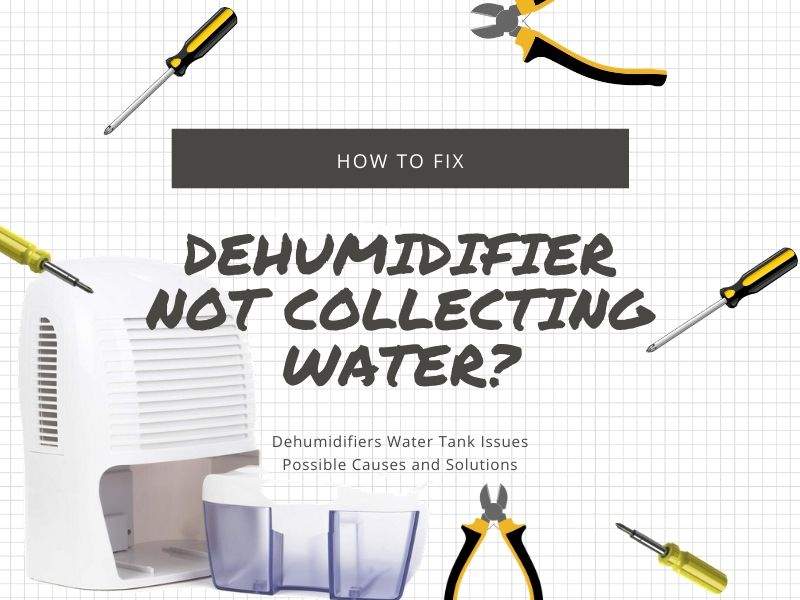Dehumidifiers are excellent for humidity control, and people all over the globe use the device. The devices vary in design and can be of different types based on functionalities and sizes. But, the outcome of using a dehumidifier is the same; air that’s good for breathing.
Most of the designs are pretty straightforward, and users can operate the devices with ease. You do need to take care of the unit to enjoy the benefits for a long time. Replacing old parts can help in maintaining efficiency, along with timely cleanups.
Sometimes, however, some issues can arise that can be bothersome for users.

In this article, we’ll be discussing the water collection problem, and more specifically, when the water tank is not collecting water. So, let’s look into the causes, as well as the solution to the water collection issues.
4 Major Dehumidifiers Water Tank Issues – Possible Causes and Solutions
There can be a few reasons for this problem. You need to check each aspect to determine the root cause before taking the next step. Let’s go over the various factors that can be at play here.
1. Problem with the unit’s Capacitor
The unit’s capacitor is a significant component, and you can find it in the compressor circuit of the device. In case the room temperature is over 65 Degrees Fahrenheit, and the dehumidifier shows no water collection, there may be an issue with the capacitor.
What the compressor does is, it circulates the refrigerant throughout the unit. This refrigerant removes the moisture from the air and collects it in the water tank. In case there is an issue with the capacitor, the compressor cannot function properly. If the overload device keeps tripping constantly, this may be your device’s problem.
To remedy the problem, you can contact a technician and perform tests to determine if the compressor is faulty.
2. Issues with the PCB Assembly, or the Electronic Control Board
When you’re looking for the reason for the water collection problem in your device, another place to look for is the PCB assembly or the electronic control of the unit.
In case your device is not collecting water, even though the temperature of the room is above 65 Degrees Fahrenheit, you should make this step.
Most modern dehumidifiers have the control board, and the control board is responsible for monitoring ambient humidity levels. It also uses its various sensors to send signals to the compressor for operation. In case there’s any fault here, the compressor doesn’t get the cue to start, and no water is collected.
To remedy this, the users can do the voltage test on the output relays with a multimeter to make sure the relays and sensors are working.
3. Issues with the Fan Motor
If the problem isn’t with the above two components, you can also check the fan motor of the device. If your device stops collecting water under the same circumstances as mentioned above, the fan motor is also a likely point of fault.
The fan motor is responsible for keeps the air rotating across the evaporator curls. It keeps the coils from being covered by ice.
There can be a lot of things at play here.
First off, you can check to see if the air is blowing air, and if so, to what degree. If the fan is producing is small amounts of air, check to see if the fan cover or the evaporator coils have any dust or debris blocking the function. If the fan motor needs to be replaced, you should do that to restore operation. Before that, check to see if the blower wheel is attached aptly to the motor shaft.
4. Issues with the Overload Device
The problem can also be with the Overload device if the unit is not collecting water.
The Overload device keeps the motor safe from any damage. Overload is an essential part of the compressor in the unit. In case there’s something wrong with the overload, the compressor stops working. When that happens, no water is collected.
It is possible to test the continuity of the overload using the multimeter.
These are a few reasons why your unit is not collecting water. If you find it complicated to sort out yourself, it is advised to seek professional help.
Final Word
There can be a couple of reasons (mentioned above) in case your device is not collecting water. You can determine the root cause of the problem using this information.
Mostly, the problem arises either from aging (or ageing) components. If that is the case, you should get them replaced. You should also do regular maintenance and cleanup to ensure that the device works properly.
Make sure to place the dehumidifier in a good location. In case the temperature is low, you should not use the humidifier since the coils may freeze up.